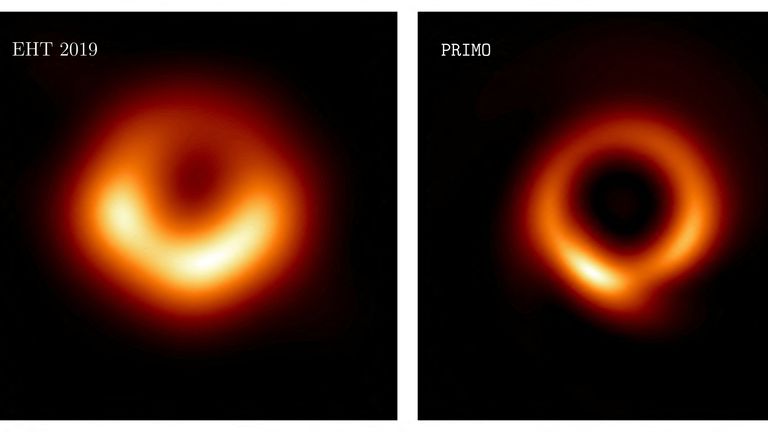Scientists have released new, clearer images of a supermassive black hole which was first discovered in 2019.
The new image retains the distinctive shape that the first image was compared to – one astrophysicist refers to the original as a “fuzzy orange doughnut” – but is far sharper.
Four years ago, the global Event Horizon Telescope project gathered the data for the first image.
The clearer updated picture was created by mining the same original data but improving its resolution through image reconstruction algorithms to fill in gaps in the original observations.
Black holes are celestial entities that have such a strong gravitational pull that no matter or light can escape.
The ring of light in the image is material being sucked into the voracious black hole.
This supermassive black hole is in a galaxy called Messier 87 (M87) about 54 million light-years from Earth. A light-year is the distance light travels in a year, which is 5.9 trillion miles (9.5 trillion kilometres).
M87 has a mass 6.5 billion times that of our sun and is larger and more luminous than our Milky Way.
Dr Lia Medeiros of the Institute for Advanced Study in Princeton, New Jersey, is the lead author of a study published in the Astrophysical Journal Letters.
She said it has been tricky to come up with a nickname for the updated image.
“I have been referring to this image as the ‘skinny doughnut,’ which sounds incredibly unappetizing,” she said.
“We’ve also discussed ‘diet donut,’ which is equally unappetising,” said the astrophysicist.
Read more:
First image of massive black hole
NASA releases audio recording of a black hole
The study’s authors are members of the Event Horizon Telescope (EHT) project, an international collaboration begun in 2012 with the goal of directly observing black holes.
An event horizon is the point beyond which anything – stars, planets, gas, dust and all forms of electromagnetic radiation – gets swallowed into a black hole.
Dr Medeiros said she and her colleagues plan to use the same technique to improve upon the image of the only other black hole ever pictured – an image released last year showing the one inhabiting the Milky Way’s centre, called Sagittarius A*.
“The EHT is a very sparse array of telescopes. This is something we cannot do anything about because we need to put our telescopes on the tops of mountains and these mountains are few and far apart from each other. Most of the Earth is covered by oceans,” said Georgia Tech astrophysicist and study co-author, Dr Dimitrios Psaltis.
“As a result, our telescope array has a lot of ‘holes’ and we need to rely on algorithms that allow us to fill in the missing data,” Dr Psaltis added. “The image we report in the new paper is the most accurate representation of the black hole image that we can obtain with our globe-wide telescope.”

